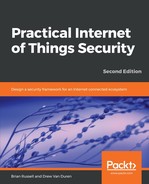There is more to discuss related to IoT asset management than simply keeping track of the physical location of each component. Some IoT devices can benefit from predictive analytics to help identify when an asset requires maintenance and also detect in real time when an asset has gone offline. By incorporating new data analytic techniques into an IoT ecosystem, organizations can benefit from these new capabilities and apply them to the IoT assets themselves.
When imaging a device such as an autonomous connected vehicle working on a construction site, or perhaps a robot on a manufacturing floor, the ability to predict failure becomes significant. Prediction is only the first step, however, as the IoT matures with new capabilities to automatically respond to failures and even autonomously swap out broken components for new replacements.
Consider a set of drones used in security and surveillance applications. Each drone is essentially an IoT endpoint that must be managed by the organization like any other asset. This means that within an asset database there is an entry for each drone that includes various attributes such as the following:
- Registration number
- Tail number
- Sensor payloads
- Manufacturer
- Firmware versions
- Maintenance logs
- Flight performance characteristics, including flight envelope limitations
Ideally, these drone platforms can also be self-monitoring. That is, the drones can be fitted with a multitude of sensors that monitor aircraft health and can feed the data back to a system capable of performing predictive analytics. For example, the drone may measure data such as temperature, strain, and torque, which can be used to predict part failures within individual components of the platform. From a security perspective, ensuring that the data is integrity-protected end-to-end is important, as is building in checks within the predictive algorithms to look for variances that should not be included in calculations. This is just one more example of where safety and security intersect in the same ecosystem.
Proper asset management requires having the ability to maintain a database of the attributes related to a particular IoT device in order to properly perform routine maintenance on each asset. IoT system deployers should consider two configuration management models:
- The IoT asset components (for example, firmware) are fully integrated and updated by the IoT device vendor in a single update
- The IoT asset is developed modularly with many different technologies that must each be maintained and separately updated
In the first instance, updating the IoT asset is straightforward, although there are still, of course, opportunities for vulnerability exploitation. Always ensure that the new firmware is digitally signed at a minimum (and that the public key trust anchor verifying the firmware signature is securely stored). Care must also be taken to secure the firmware distribution infrastructure, including the systems that provision the signing certificates in the first place. When new firmware is loaded into an IoT platform, the platform should verify the digital signature using a protected trust anchor (public key) before allowing the firmware to boot and load into executable memory. In addition to digitally signing firmware packages, verify that the devices are configured to only allow signed updates.
